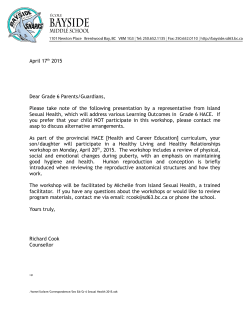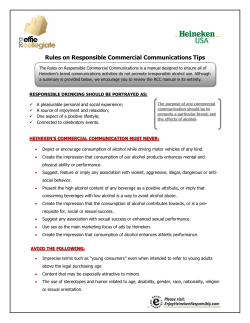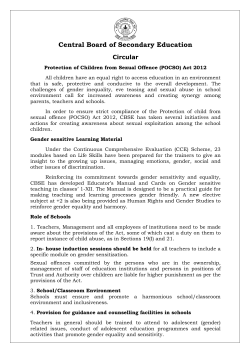
Tips for Parents - Parent Involvement Committee
SEX EDUCATION IN ONTARIO Tips for Parents Sex Education In Ontario Ontario’s New Sex Education Curriculum has received a lot of attention over the past few weeks. This tip sheet will help to answer some of the questions that have been raised. What is different in the updated curriculum being introduced in September 2015? Examples illustrate expectations • Most of the material in the new curriculum is the • In grade 3, students are expected to learn same as the old curriculum. The new materials how visible and invisible differences make reflect changes in our society over the past 15 years, each person unique, and identify ways of including increased access to online m aterials, showing respect for differences in others. cyber-bullying, sexting, and consent issues. • Possible examples of visible d ifferences: • The updated curriculum has more detailed informaskin, hair, and eye colour, facial features, body tion, more examples, and more ‘teacher prompts’ to size and shape, p hysical aids or different help teachers respond to questions and issues that physical abilities, clothing, possessions. may be raised by students. • Possible examples of invisible d ifferences: • For example, in the old curriculum, students in grade learning abilities, skills and talents, 1 were expected to be able to “identify the major personal or cultural values and beliefs, parts of the body by their proper names”. The new gender identity, sexual orientation, family curriculum says that students should be able to background, personal preferences, a llergies “identify body parts, including genitals, using correct and sensitivities. terminology”. There is a teacher prompt that says “We talk about all body parts with respect. Why is it important to know about your own body, and use correct names for the parts of your body?” • The teacher prompts in the curriculum documents are NOT mandatory, and may never be mentioned in Why is the curriculum so explicit the classroom. They are there to help the teacher respond to questions that students may ask, and detailed? • Curriculum documents are written for teachers, but they are not required content, and teachers not for students. Teachers use their professional can adjust the language to ensure that it is judgement to decide how the curriculum will be age-appropriate. taught. They will not necessarily use the exact language of the curriculum in the classroom. What do students learn in Grades 1–3? • The curriculum documents include overall From grades 1–3, the health curriculum focuses on expectations (for example, the grade 4 curriculum teaching students how to take responsibility for their says that students should be able to “demonstrate own safety, how to stand up for themselves, and how an understanding of factors that contribute to to get help in situations of abuse. healthy development”) and specific expectations • In grade 1, students learn the names of all their (for example the grade 4 curriculum says students body parts, and begin to learn how their bodies work should be able to “describe the physical changes and develop. Every other province in Canada has a that occur in males and females at puberty”). similar learning expectation for grade 1 students. SEX EDUCATION IN ONTARIO • In grade 2, students learn the basic stages of human development (infant, child, adolescent, adult, older adult) and related bodily changes. • In grade 3, children learn about visible and invisible differences and how to show respect for differences in other people. Sexual orientation is included as an example of an invisible difference, along with things like cultural values and beliefs and family background. What do students learn in Grades 4–6? • • • • Because students enter puberty between the ages of 8 and 14, the curriculum expectations from grades 4–6 focus on understanding the physical, emotional, and social changes that students are going through. The goal is to demystify the changes and sensations students may be experiencing. Along with learning about their bodies, they learn how to behave respectfully toward others, including appropriate online behaviour. In grade 4, students learn about the physical changes that take place during puberty. In grade 5, they learn about the parts of the reproductive system, menstruation, and spermatogenesis and how they relate to reproduction. In grade 6, students learn about the effects of stereotypes, including things such as assumptions regarding gender roles, sexual orientation, gender expression, race, and mental health. They learn how to make decisions that show respect for themselves and others and help to build healthier relationships. If they ask about masturbation, the curriculum provides prompts for teachers to use in response. What do students learn in Grades 7–8? At this age, students are developing their sense of personal identity (including sexual identity) and may be starting to develop relationships. • In grades 7 and 8, students learn about sexual health and safety, the concept of consent, and how to make decisions about sexual activity. They learn about the importance of having a shared understanding with a partner about delaying sexual activity until they are older, and they learn that “sex” doesn’t include only intercourse, so there are teacher prompts for answering questions about anal and oral sex. Students also learn about contraception and condom use for pregnancy and disease prevention. Were parents consulted? • Consultations on the new curriculum began in 2003. Curriculum writers consulted with education and health experts, parents, students, teachers and cultural and religious groups. Parent groups, including all school boards’ Parent Involvement Committees, were asked to get input from local parents about the new curriculum. • The Ministry of Education held full-day consultations on the new curriculum, and over 70 health-related organizations and 2,400 individuals provided input on the draft curriculum. • The Ministry of Education held another round of consultations in 2014 with students and parent groups, as well as surveying 3,900 parents – one in each of Ontario’s elementary schools. Does the curriculum encourage sexual activity? No. In fact, research shows that students who get comprehensive sexual education are more likely to delay the onset of sexual activity, and have lower rates of abortions and teen pregnancies. Can students be exempted from sex education classes? Any time parents have a question or concern about what their child is learning, they should talk to the teacher or principal. School staff can address any concerns and provide more information about the curriculum content. Then, a determination can be made on a case by case basis regarding withdrawal from particular parts of the curriculum. People for Education is your strong voice for public education. We conduct vital research, answer parents’ questions, make policy recommendations and ensure there is broad coverage of education issues in the media. Together we make Ontario’s schools great! People for Education 641 Bloor Street West, Toronto, ON M6G 1L1 Tel. 416-534-0100 www.peopleforeducation.ca
© Copyright 2025









